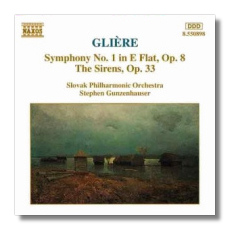
The Internet's Premier Classical Music Source
Related Links
- Glière Reviews
- Latest Reviews
- More Reviews
-
By Composer
-
Collections
DVD & Blu-ray
Books
Concert Reviews
Articles/Interviews
Software
Audio
Search Amazon
Recommended Links
Site News
 CD Review
CD Review
Reinhold Glière

Symphony #1
- Symphony #1 Op. 8 (1900)
- Symphonic Poem "The Sirens" Op. 33 (1908)
Slovak Philharmonic Orchestra/Stephen Gunzenhauser
Naxos 8.550898 - 49min
Reinhold Glière (1875-1956) was hardly a great symphonist. At best, he did not even approach the level of his countryman, Alexander Glazunov. We remember Glière best for a single number from the Soviet-era "Red Poppy" Ballet - that ubiquitous pops concert encore, 'The Russian Sailors' Dance'. His sole claim to symphonic fame is the sprawling, bombastic, discursive, seemingly endless, yet endlessly fascinating "Ilya Muromets" Symphony #3.
Glière began his First Symphony shortly before the dawn of the 20th century while still a student at the Moscow Conservatory. It shows the young Glière as a composer of some talent, but little originality or inspiration. He seems to have taken the formula for this work straight from his text books. No doubt Glière's teachers were pleased, if rather mystified that he chose to publish the result. (Even Serge Prokofieff, a one-time Glière student, had the good sense not to issue the symphony he produced while still in school.) In this frankly bland work, Glière takes no risks. Everything is precisely in its place, yet nothing stands out or leaves a lasting impression. Perhaps this is because we've heard it all before - and heard it done so much better by Tchaikovsky, Borodin, and the other great Russian nationalists. Even the sympathetic - though uncredited - notes mention Glière's "tendency to over-use sequential devices". The scoring, at least, is superb and as richly colorful as the jewels of the Tsar's favorite Easter eggs. Glière was the son of a wind instrument maker, and his scoring for these instruments is always enchanting and effective.
The orchestra is fine, boasting a lush string complement. After a generally well played first movement, however, they appear to be sight-reading, especially the ragged violins. Meanwhile, conductor Gunzenhauser comes as close to igniting as a damp match at a rainy Fourth of July picnic. Again and again, he allows tension to dissipate. He slows the tempo inexplicably when he should press forward, and he invariably understates climaxes and dynamic contrasts. Moreover, his orchestra has been far too closely miked, lending a harsh, often unpleasant edge to the strings.
That Glière was a master musical story-teller there is no doubt. The "Ilya Muromets" Symphony is ample proof of his considerable abilities in this vein, as is the symphonic poem titled "Sirens" that fills out this disc. The tale is not related in the otherwise helpful booklet notes, thought it is hardly necessary. Glière's music alone makes everything crystal clear. The cellos and harps at the outset depict the depths of the sea. The slow rising and falling of the violins mirror the cresting of the waves. (The idiom will be familiar to anyone who knows Rimsky-Korsakov's "Sadko".) The sirens themselves finally appear at 3:34, sounding like direct descendents of Wagner's Rheinmaidens with a hint of Scriabin, whose "Poem of Ecstasy" was completed in 1908 - the same year as "Sirens". Their cloying five-note motif is repeated tediously with little or no variation. The sirens' song builds to a fortissimo climax around 6:00, after which they slowly submerge beneath the surface to the accompaniment of descending scales in the strings. An unsuspecting sailor is heard in the distance, as signaled by the horns at 6:18. He approaches boldly. Suddenly, the sirens break through to the surface. Their song intertwines seductively with the sailor's dashing theme. Gradually the sirens become more insistent. Then, with a crash of the cymbals, they mercilessly drag their victim under the water. The bassoon and the chattering of the double basses portray the unfortunate sailor's final resting place at the bottom of the sea. Eventually calm is restored, and peace returns to the kingdom of Neptune.
Gunzenhauser leads a richly colorful and atmospheric performance, and he has drilled his orchestra far more thoroughly here than in the symphony. Naxos' program is short, but if you want to hear intriguing symphonic poem that concludes the disc, this is your only choice for now.
Copyright © 1997, Tom Godell


















